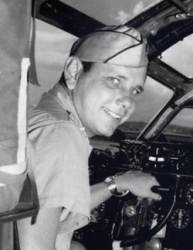
 |
|
|
||
|
Charles Donald Albury |
||||
|
Engagements: • World War II (1941 - 1945) |
||||
| Biography: | ||||
|
Charles Donald Albury Charles Donald Albury was born on 12 October 1920 at his parents' home in Miami, FL. As of 2009, the Miami Police Department building stands on the site of Albury's birthplace. Albury enrolled at the University of Miami's Engineering School, but dropped out before he completed his bachelor's degree in order to enlist in the U.S. Army Air Corps during WW II. He joined the 509th Composite Group in 1943. The 509th Composite Group also included Colonel Paul Tibbets, who would later command the Enola Gay during the atomic bombing of Hiroshima. Both Albury and Tibbets trained at Wendover Air Force Base, located in Utah. However, none of the men being trained at the base knew exactly what kind of mission they were training to carry out. Hiroshima Albury was deployed as a pilot to the Pacific Theater of Operations. On 6 August 1945, Captain Albury witnessed the first atomic bombing of Hiroshima as pilot of the instrument observation plane, The Great Artiste, which accompanied the Enola Gay commanded by Tibbets. Albury measured the levels of radioactivity and magnitude of the atomic bomb from his plane. He would later state in an interview with Time Magazine, "When Tibbets dropped the bomb, we dropped our instruments and made our left turn. Then this bright light hit us and the top of that mushroom cloud was the most terrifying, but also the most beautiful, thing you've ever seen in your life. Every color in the rainbow seemed to be coming out of it." Nagasaki On 9 August, just three days after the bombing of Hiroshima, Albury was chosen to co-pilot the B-29 Superfortress Bockscar, which would drop the atomic bomb known as "Fat Man" on the city of Nagasaki. Bockscar was piloted by Major Charles Sweeney (1919-2004). The attack was delayed by cloud cover until the crew located a hole in the clouds. Bockscar dropped the 10,200-pound "Fat Man" on the city of Nagasaki, instantly killing 40,000 people. An additional 35,000 Japanese citizens would succumb from radiation sickness and other injuries in the aftermath of the bombing. Albury stated repeatedly during his life that he did not have any remorse for the attack, or his role in the attack, on Nagasaki. He said that many more lives would have been lost if the U.S. had launched a full invasion of mainland Japan. Post-Military Life Following the end of World War II, Albury moved to Coral Gables, FL, with his wife, Roberta. He chose a career as a commercial airline pilot for the now defunct Eastern Airlines, where he crossed the picket line during the 1989 strike. Albury later became the co-manager of Eastern's Airbus A300 training program. Death and Burial Charles Donald Albury died on 23 May 2009 at a hospital in Orlando, FL, at the age of 88. He is buried at Miami Memorial Park Cemetery in Miami, FL. Albury had suffered from congestive heart failure for several years before his death, but lived a full and happy life. He was the last surviving crew member to have seen both atomic blasts. |
||||
| Honoree ID: 2050 | Created by: MHOH | |||
Ribbons
Medals
Badges
Honoree Photos
 |  |  |
 |  |
 |


